Just How Mycotoxin Testing Aids Prevent Contamination and Safeguard Food Supplies

Mycotoxin testing is an indispensable practice in the food industry, serving as a frontline protection versus contamination by harmful toxins generated by molds. With the application of innovative methods like High-Performance Liquid Chromatography (HPLC) and Liquid Chromatography-Mass Spectrometry (LC-MS), food manufacturers can properly quantify and discover mycotoxin degrees in agricultural products. This positive strategy not just makes sure compliance with stringent safety and security laws yet likewise mitigates health and wellness risks to consumers. Furthermore, routine screening strengthens brand reputation and financial health by reducing contamination-related events. How precisely do these screening procedures incorporate right into the wider food security method?
Understanding Mycotoxins
Recognizing mycotoxins begins with identifying that they are toxic additional metabolites generated by certain molds, which can infect agricultural products. These metabolites are not crucial for the growth or recreation of the fungis however can have severe implications for human and animal health and wellness. Mycotoxins are frequently discovered in staple crops such as corn, wheat, barley, and nuts, where they can proliferate under specific conditions of moisture and temperature level.
There are several sorts of mycotoxins, each generated by different fungal varieties. Aflatoxins, produced by Aspergillus varieties, are among the most notorious, recognized for their cancer causing properties. One more considerable group consists of ochratoxins, generated by Aspergillus and Penicillium types, which have nephrotoxic effects. Fusarium types produce fumonisins and trichothecenes, both of which are linked with various acute and chronic health and wellness problems.

Threats of Mycotoxin Contamination
The threats of mycotoxin contamination are multifaceted, posturing substantial risks to both food safety and public health. Mycotoxins, poisonous compounds created by particular sorts of fungis, can pollute a variety of farming products including cereals, nuts, flavors, dried out fruits, and coffee. When these toxic substances penetrate the food supply, they can lead to significant health and wellness problems such as liver damages, kidney failing, and even cancer. Susceptible populaces, including kids, the elderly, and immunocompromised individuals, are specifically at risk.
Financial effects are one more significant worry. Polluted plants can lead to significant monetary losses for farmers and food producers because of lowered yields and the need for pricey decontamination actions. Furthermore, global profession can be dramatically hindered as countries impose strict mycotoxin laws to safeguard their populations, leading to rejected shipments and strained trade relations.
Ecological factors such as climate change intensify the risk of mycotoxin contamination. Variants in temperature level and humidity can produce beneficial conditions for fungal growth, raising the probability of contamination events. Therefore, understanding and mitigating these dangers are vital for guaranteeing the safety and security and stability of international food supplies.
Methods of Mycotoxin Examining
Precisely identifying mycotoxin contamination in farming items is vital for protecting public health and keeping food security standards. Numerous techniques are utilized to spot and evaluate mycotoxins, each offering particular advantages and restrictions.
High-Performance Fluid Chromatography (HPLC) is a widely utilized approach due to its high sensitivity and accuracy. It includes separating mycotoxins from other compounds in an example, enabling accurate metrology. Similarly, Fluid Chromatography-Mass Spectrometry (LC-MS) combines liquid chromatography with mass spectrometry to offer detailed molecular details, making it specifically helpful for recognizing numerous mycotoxins concurrently - Mycotoxin testing Services.

Gas Chromatography-Mass Spectrometry (GC-MS) and Thin-Layer Chromatography (TENDER LOVING CARE) are additionally utilized, each with distinct applications. GC-MS works for volatile mycotoxins, while tender loving care offers an easier, cost-effective option for preliminary testing.
Benefits of Regular Checking
Regular screening for mycotoxins in agricultural products supplies many advantages, substantially contributing to public wellness and food safety and security. By identifying contamination early, routine testing helps prevent the circulation of hazardous foods, thereby minimizing the danger of mycotoxin-related ailments amongst consumers. This positive method not just safeguards human health however additionally improves the general top quality of food materials.
Different countries and regions have developed rigid limits for mycotoxin degrees in food and feed. Adhering to these limitations via routine testing makes certain that manufacturers and vendors satisfy legal requirements, consequently avoiding charges and profession obstacles.
Furthermore, normal mycotoxin testing can bring about considerable financial benefits. Early discovery of contamination permits timely treatment, reducing prospective losses from widespread contamination. Executing normal screening methods can additionally decrease recall prices and associated liabilities, which can be financially devastating.
Furthermore, routine testing supplies useful data that can educate better farming practices and storage conditions. By recognizing patterns of contamination, manufacturers can embrace preventive steps, thus reducing future dangers and adding to the sustainability of the food supply chain.
Executing Checking Protocols
Executing effective mycotoxin screening protocols is important for making sure the safety and security and quality of farming items. Each phase needs to be inspected to determine where mycotoxin contamination is most likely to happen.
When critical control factors are recognized, choosing proper testing techniques is essential. Usual techniques include enzyme-linked immunosorbent assay (ELISA), high-performance fluid chromatography (HPLC), and mass spectrometry (MS) Each approach has its weaknesses and toughness; therefore, choosing the proper one depends on the details mycotoxin being checked, the called for sensitivity, and readily available sources.

Lastly, integrating the testing protocols right into an extensive food safety monitoring system is a good idea. This boosts traceability and makes it possible for quick restorative actions when contamination is found, thus safeguarding the stability of the food supply chain.
Final Thought
Mycotoxin screening is essential in preventing browse around this site contamination and guarding food supplies by allowing very early discovery of damaging toxic substances generated by mold and mildews in farming items. Regular screening improves brand name credibility, financial security, and depend on in food security by minimizing contamination-related losses and preserving high requirements in food manufacturing.
Mycotoxin screening is an essential technique in the food sector, serving as a frontline defense versus contamination by damaging contaminants produced by molds. An incorporated approach including agricultural techniques, storage space administration, and regular screening can reduce the dangers connected with mycotoxin contamination, making sure food have a peek at these guys safety and security and public health and wellness.
The risks of mycotoxin contamination are diverse, posturing substantial dangers to both food safety and public wellness.Regular testing for mycotoxins in farming items offers countless advantages, considerably adding to public health and wellness and food safety and security.Mycotoxin testing is crucial in stopping contamination and protecting food materials by allowing very early detection of unsafe toxic substances generated by mold and mildews in farming items.